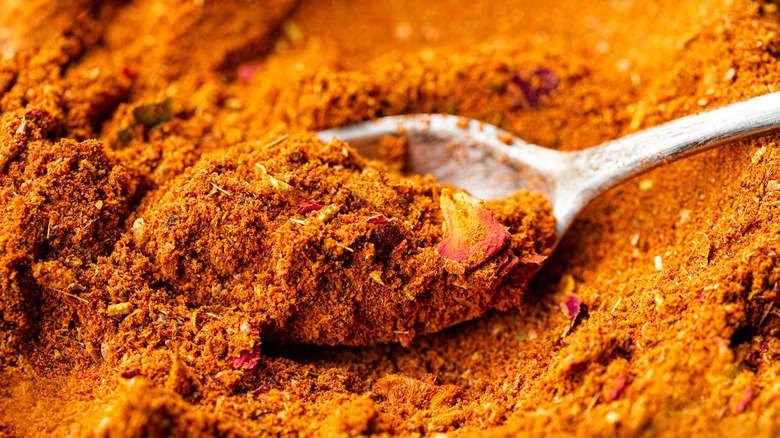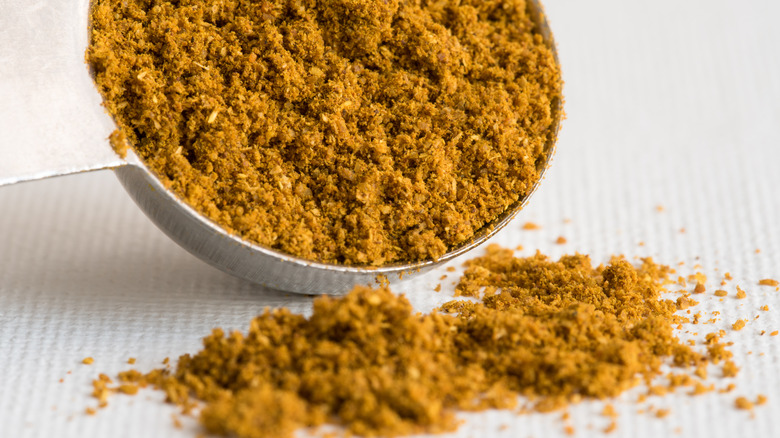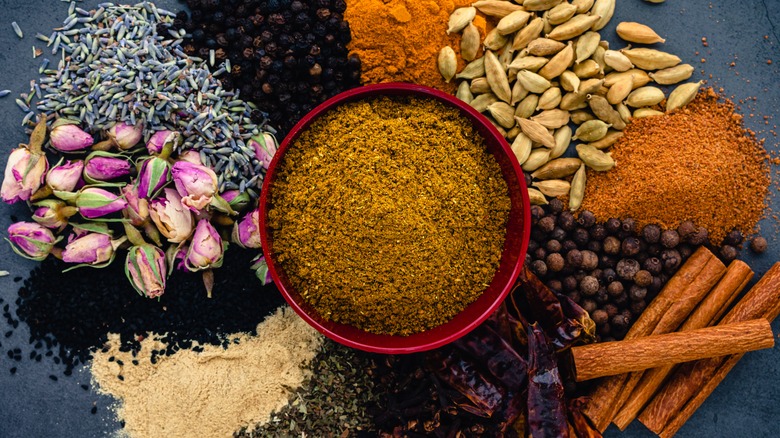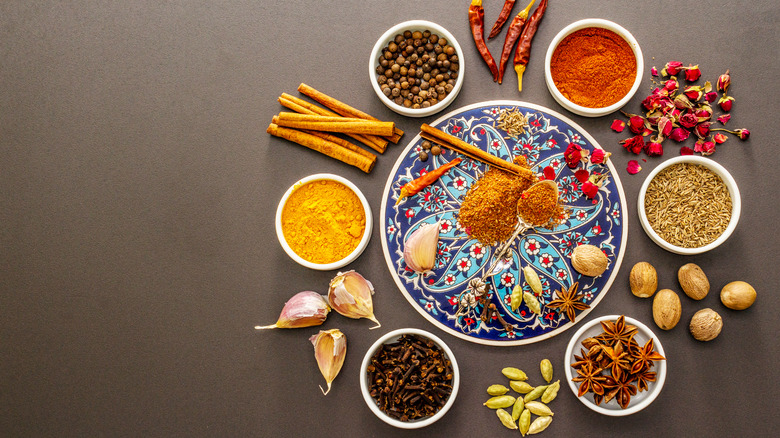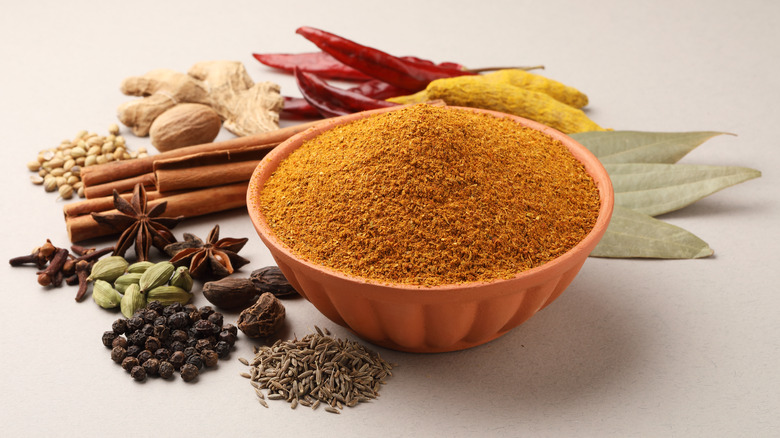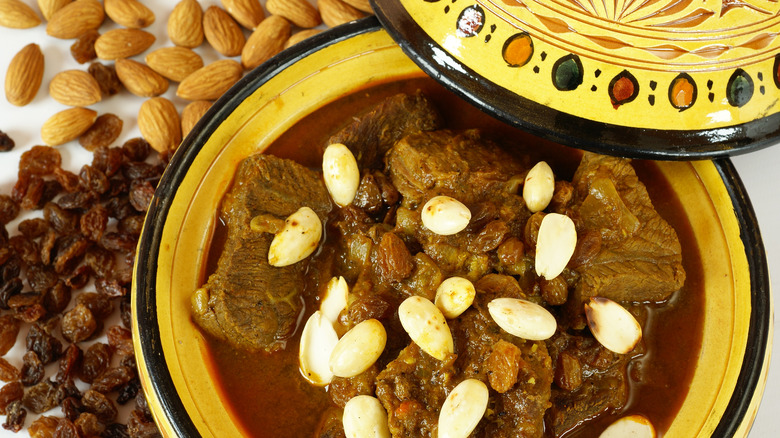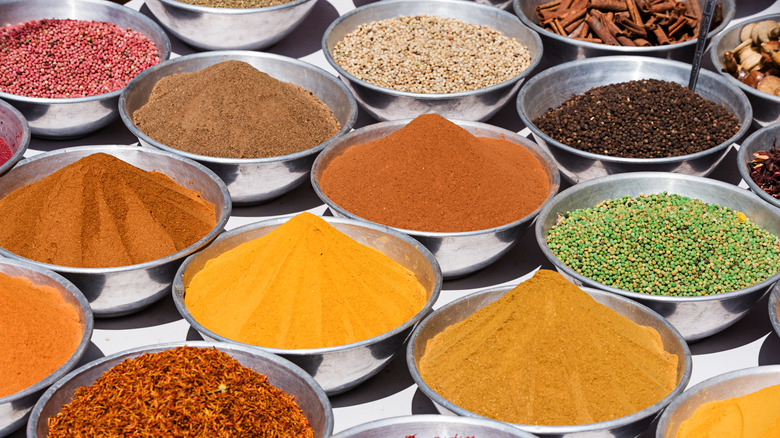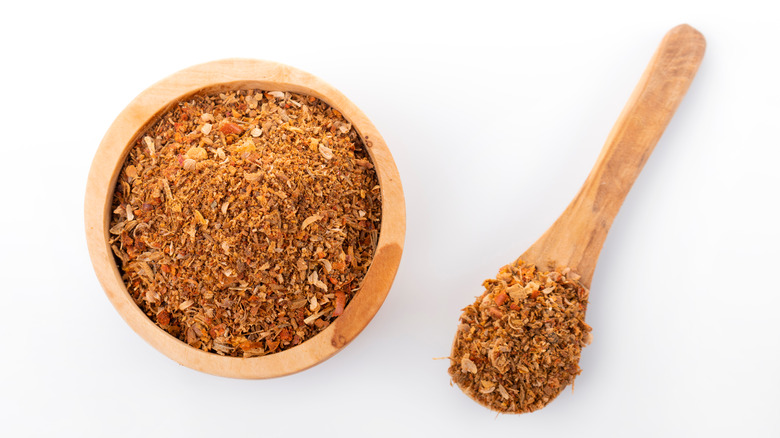Ras El Hanout, The Classic Spice Blend To Boost Rich Meat Dishes
North African cuisine is defined, in part, by a diverse array of herbs and spice blends. In fact, every evening, locals are drawn into the medinas of cities like Marrakesh, Morocco, and Cairo, Egypt, that transform into the outdoor markets that are famous in North Africa and the Middle East, also known as souks. There, vibrantly colored spices are brought home and mixed into the flavor blends that have come to permeate North African cuisine — one of the most well-known being Ras el Hanout.
Literally translating from Arabic to "head of the shop," but really meaning "top shelf," Ras el Hanout is a spice blend that originated in Tunisia, Algeria, and Morocco — but its exact combination of spices can be difficult to put a finger on. While both translations of Ras el Hanout refer to it being the best spice in the spice shop, its flavors can vary from vendor to vendor, and there's no singular recipe you can follow. Just as with other North African foods like harira, no two Ras el Hanouts you try will ever be the same.
What is Ras el Hanout?
Ras el Hanout is a spice blend that originated in North Africa, in the countries of Tunisia, Algeria, and Morocco, to be specific. However, the blend is most popular in Morocco, where it is used in everything from meat and vegetables to soups and tagines. In fact, the blend is so widely used in Moroccan cuisine that you may even come across Ras el Hanout labeled as a Morrocan spice blend — and a blend it sure is; however, they may be a bite of an understatement.
Ras el Hanout is famous for its lengthy list of rare ingredients. From rose buds and lavender to galangal and orris root, nigella seeds, and grains of paradise — just to name a few — Ras el Hanout is thought to be one of the most complex spice blends on Earth. With blends made up of anywhere from 25 to 80 different spices, you can bet that complexity shines through in each and every bite.
How is Ras el Hanout made?
From the traditional Moroccan soup, harira, to other famous spice blends like chermoula, many North African foods vary depending on where you are in the region — and Ras el Hanout is no exception. From city to city, market to market, and kitchen to kitchen, no two Ras el Hanout blends you try will be the same. However, that element of personalization only adds to the spice blend's allure. While most Ras el Hanout blends begin with a base of black pepper, white pepper, cinnamon, nutmeg, allspice, anise cloves, ginger, cumin, coriander, cayenne, turmeric, and sumac, depending on where you are and who makes it, any of those ingredients could be added to or replaced.
When it comes to making Ras el Hanout, don't expect to get a spice vendor's help — many tend to hold their recipes close to their hearts. With anywhere from 25 to 40 different spices in any given blend, the best you'll get is which spices they use, but not necessarily how much. That's where experience comes in, as each spice must be added carefully and in the right amount to ensure the perfect balance. While it's traditionally made by grinding whole spices, leaves, and roots together by hand, Ras el Hanout can be made using the pre-ground spices you have at home — however, the flavors won't be as robust. With some variations including as many as 80 different spices, at its core, Ras el Hanout is a blend of warm and fragrant spices with floral and sweet notes that aren't inherently spicey, that is, unless it's added. It's the fluidity of its recipe that makes it so sought after.
What does Ras el Hanout taste like?
Given its regionality, Ras el Hanout won't taste the same depending on where you get it and who made it. But that's not to say it doesn't have a distinguishable flavor profile. Commonly featuring a base of black pepper, white pepper, cinnamon, nutmeg, allspice, anise cloves, ginger, cumin, coriander, cayenne, turmeric, and sumac, you can expect Ras el Hanout to taste sultry and aromatic. With notes that are both sweet, floral, earthy, and hearty, Ras el Hanout hits all the flavor marks one could possibly think of.
However, there's also the question of its regionality that is worth noting. As discussed, both the number and types of spices used in any given blend of Ras el Hanout can vary depending on where you are and who made it. For instance, in Morocco, the country where the spice is used most heavily, many regions will include spices like cumin and fenugreek, among dozens of other spices, while others may not. In the city of Fez, for example, blends tend to leave these out so their blend can lend to a more peppery, floral flavor.
Keep in mind that this is just one example, and you will find many other variations of the blend across Morocco and other countries in North Africa. Just know that you can always expect some amount of warmth, and earthiness, balanced by sweet and floral notes. The blend is not inherently spicy but can sometimes be made that way with the addition of cayenne.
Ras el Hanout vs Garam Masala
It's not uncommon to find people comparing Ras el Hanout to Garam Masala, a spice blend that originated in India, where it is used widely from India to Pakistan and Iran. In retrospect, it's a fair comparison: they both vary depending on their regionality and are both very versatile in their uses, as they can be found in everything from meat to soups and stews. Made from a blend of cinnamon, green cardamon, black peppercorns, coriander, cumin, mace, and bay leaves — which, minus the bay leaf, can all also be found in Ras el Hanout — they undoubtedly have some similarities, but they also have some key differences too.
Used in the most famous of Indian dishes, from Chana Masala to butter chicken, Garam Masala has a notoriety in South Asia that is arguably as well known as Ras el Hanout in the Middle East. But, while they may contain some similar ingredients, in the end, they cannot be compared much more beyond their fame. Complex, with notes of earthiness, sweetness, and spice, garam masala is aromatic like Ras el Hanout but in a different way. While Ras el Hanout tends to be floral and sweet, containing notes of rose, lavender, and cinnamon, Garam Masala sticks to the savory end of the spectrum and inches more into the spicey category the further south you travel.
Cooking with Ras el Hanout
It should be said that most people, even North Africans, don't cook with Ras el Hanout on a daily basis. Given its lengthy ingredient list and combination of rare and exotic spices, Ras el Hanout is typically reserved for the most special of occasions. Traditionally, Ras el Hanout is found in specialty dishes of the likes of B'stilla, a Moroccan sweet and savory pie, and Mrouzia, a slow-cooked lamb tagine. In fact, this application is so well-known that Ras el Hanout is also known as "Mrouzia spice" by some.
However, Ras el Hanout also works fantastically in more everyday dishes like Moroccan meatballs, whether they're made from lamb or beef. It also works impeccably when applied as a spice rub or marinade in your go-to meat and seafood dishes. Whether they're grilled or roasted, Ras el Hanout will boost the richness of all your favorite proteins — even things like tofu and mushrooms, for you vegans and vegetarians. You can also toss it on your vegetables with a bit of olive oil before roasting for a uniquely flavored side dish.
Where to buy ras el hanout
As with other North African spices, the best place to source your Ras el Hanout is from a spice vendor at one of the many famous souks in the region. Given the lengthy ingredients needed to make Ras el Hanout, most people, including North Africans, tend to buy their favorite mixes from one trusted spice seller and one seller only (that is, if they don't make it themselves at home). As explained before, not one Ras el Hanout blend is made the same as the next, so once you've found a blend you like, the only way to experience it again is if you go back to the same place. Some local sellers, such as the Benchekroun family in Fez, Morocco, have built reputations for having the best blend in their area.
That being said, there are other ways to get your hands on some Ras el Hanout. New York Shuk is a brand that specializes in Middle Eastern spice blends, and they sell Ras el Hanout in shakers. There's also Villa Jerada, another brand that specializes in Levantine and Moroccan foods that sells a Ras el Hanout blend by the jar. But, just like in North Africa, no two Ras el Hanout blends are the same. While the store-bought versions are a good place to start, you may end up dressing them up with your own added spices as you gain experience with the different varieties of flavors in the blend.
Varieties of ras el hanout
The sheer variety of spices that can be included, or not included, in a blend of Ras el Hanout is what makes the spice blend so universally loved — but it can also be a bit overwhelming. While it'd be impossible to identify all of the different combinations of Ras el Hanout that are out there; you can take a more generalized approach to identify different varieties. In general, some of the most common spices used in Ras el Hanout include black and white peppercorns, turmeric, coriander, anise seeds or cloves, ginger, cinnamon, nutmeg, and cumin — but those aren't a guarantee. Any one of those spices can be added to or replaced, depending on where you get your Ras el Hanout from and who made it.
For example, the store-bought version of Ras el Hanout from New York Shuk only contains six ingredients, while the jars from Villa Jerada contain 14 — both relatively short ingredient lists compared to what you'll get from spice traders in Morocco. However, it's not solely about the number of spices used but the quality. Blends found in Morocco and other parts of North Africa tend to contain many rare and exotic spices. From ash berries and chufa nuts to cubebe and guinea pepper, among many others, a good blend of Ras el Hanout will contain at least a dozen ingredients, both common and rare, in different proportions. While commercial blends will tend to contain fewer ingredients of less rarity.
